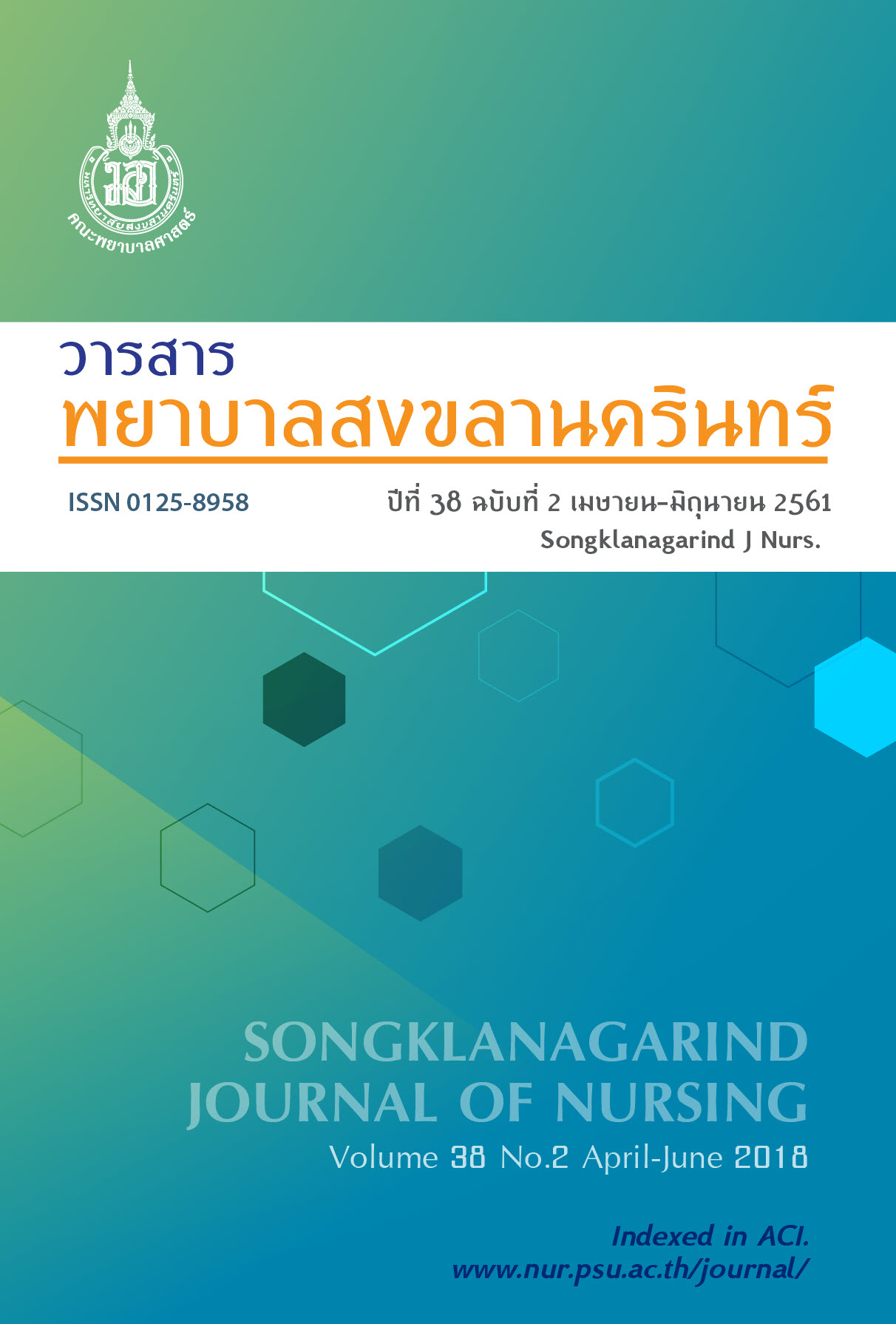The Implementation of the Project of Reducing Teenage Pregnancy in Four Municipalities of Songkhla: A Case Study The Implementation of the Project of Reducing Teenage Pregnancy
Main Article Content
Abstract
This study aimed to explore the characteristics and imprementation of the project of reducing teenage pregnancy in four municipalities of Songkhla. The 45 participants were included into this study by purposively voluntary sampling technique. They were administrators, personnel, community and student volunteers, teenagers and parents. Data collection techniques included in-depth interview, focus group discussion, observation and documentation. Content analysis method was used to analyze the data.
The result showed that the project comprised of five core characteristics. There are 1) underpinning by concept of sexuality education, 2) having three target groups: personnel, volunteers, and teenagers and their parents; 3) using community-based type, 4) focusing on skill development; and 5) applying three strategies multi-leveled (participation, networking, and capacity building). In addition, the project implementation which is setting-based revealed in three differences. There are systematic approach that presented in the large-sized municipality, problem approach that presented in the medium-sized municipality and activity approache that presented in the medium and small-sized municipalities. Using different approach to operate project in settings seem to be influenced by the setting contexts such as organizational, situational and cummunity contexts. The abilities of project coordinators may also significant to operating approach in setting.
The study findings indicate that community-based project for teenage pregnancy requires an integration of concepts, contents, design, and methods that appropriated to setting contexts and organizational structure.
Article Details
References
2. Wikigender.org. Youth pregnancy in Thailand. [homepage on the internet]. [cited 2018 May 15]. Available from: https://www.wikigender.org/wiki/ youth-pregnancy-in-thailand/
3. UNICEF, unite for children. Situational analysis of teenage pregnancy of Thailand: Report 2016. Bangkok: UNICEF Thailand; 2016. Thai.
4. Bureau of Reproductive Health, Ministry of Public Health. [Homepage on the internet]. Adolescent reproductive health: Thailand profile 2015. [cited 2018 May 15]. Available from: http://rh.anamai. moph.go.th/more_news.php?cid=1&filename=index.
5. UNESCO. International technical guidance on sexuality education: An evidence-informed approach for schools, teachers and health educators. Bangkok: UNESCO Bangkok, Thailand; 2012. Thai.
6. Kegler MC, Williams CW, Cassell CM, et al. Mobilizing communities for teen pregnancy prevention: Associations between coalition characteristics and perceived accomplishments. J Adolesc Health. 2005; 37: S31- 41. doi: 10.1016/ j.jadohealth.2005.05.011
7. Kupermine GP, Holditch PT, Allen JP. Volunteering and community service in adolescence. Adolesc med. 2001; 12(3): 445-57.
8. Gavin LE, Catalano RF, David-Ferdon C, et al. A review of positive youth development programs that promote adolescent sexual and reproductive health. J Adolesc health. 2010; 46: S75-S91. doi: https://doi.org/10.1016/j.jadohealth.2009.11.215
9. UNICEF, Ministry of Education. Report of reviewing the sexuality education in formal education of Thailand. Bangkok: UNICEF Thailand; 2016. Thai
10. Bureau of Reproductive Health, Ministry of Public Health. Communication about Sex in Thai families.
angkok: Agricultural Cooperative Printing Demonstrations Thailand; 2014. Thai
11. Department of Health.org, Ministry of Public Health. [homepage on the internet] Act for prevention and solution of the adolescent pregnancy B.E. 2016 [cited 2018 May 15]. Available from: http: //rh.anamai.moph.go.th/download/all_file/index/ Teen%20Pregnancy%20Act%20Certified%20 Version%20(1).pdf
12. Chirawatkul S, Fongkaew W, Settheekul S. et al. Integration model for the prevention of and solution to teenage pregnancy: Concept and operation. Thai Journal of Nursing Council. 2017; 32(3): 5-24. Thai.
13. Sriwanitchakorn S, editor. Immunization for children, youths and families: The summary of the 9th forum of community health system. ASEAN Institute for Health Development, Mahidol University: Nakon Patom; 2012.Thai.
14. PATH organization. Project to promote sexual health and reduce teen pregnancy rate in four municipalities of Songkhla. [homepage on the internet]. 2017 [cited 2018 Jun 29] Available from: https://www.path2health.or.th/content/2499
15. Purinthrapibal S, Singchongchai P, Rungpitarangsee P, et al. Report of implementation evaluation of the project to promote sexual health and reduce teen pregnancy rate in four municipalities of Songkhla, Phase I from June 2016 to October 2017. (Mimeographed). Thai
16. Stake RE. Case studies. In: Denzin NK, Lincon YS. (Eds.), Handbook of qualitative research. Thoundsan Oaks, CA: SAGE; 2000. (pp. 435-454)
17. Elo S, Kyngäs H. The qualitative content analysis process. J Adv Nurs. 2008; 62(1): 107-15. doi: 10. 1111/j.1365-2648.2007.04569.x
18. PATH organization. Guideline of training program for Teenagers to promote sex-related health. (Mimeographed). Thai
19. Teenpath project, PATH organization. Guidebook of training program for communication between parents and children to promote sex-related health. Bangkok: PATH organization; 2011. Thai
20. European Expert Group on Sexuality Education. Sexuality education – what is it?. Sex Education. 2016; 16 (4): 427-31. doi: 10.1080/14681811.2015.1100599
21. Oyedele OA, Wright SCD, Maja TMM. Community participation in teenage pregnancy prevention programmes: A systematic review. J Res Nurs Midwifery. 2015; 4 (2): 24-36. doi: 10.14303/JRNM.2015.039
22. Bureau of Reproductive Health, Ministry of Public Health. Teenage pregnancy policy, guideline, monitoring and evaluation. Bangkok: Agricultural Cooperative Printing Demonstrations Thailand; 2014. Thai.
23. Ingham R. Teenage pregnancy: Some learning from England. Paper presented at: National Conference on Health Sexuality; 2014 Sep 8-10; Bangkok, Thailand.
24. Mueller T, Tevendale HD, Fuller TR, et al. Teen pregnancy prevention: Implementation of a multicomponent, community-wide approach. J Adolesc Health. 2017; 60: S9-17. doi: 10.1016/j.jadohealth.2016.11.002
25. Leeman J, Calancie L, Hartman M, et al. What strategies are used to build practitioners’ capacity to implement community-based interventions and are they effective?: A systematic review. Implement Sci. 2015; 10 (80): 1-15. doi 10.1186/ s13012-015-0272-7
26. Health Education Division, Ministry of Public Health. Networking and participation development to promote community health behaviors. Nontaburi: Ministry of Public Health; 2013. Thai.


